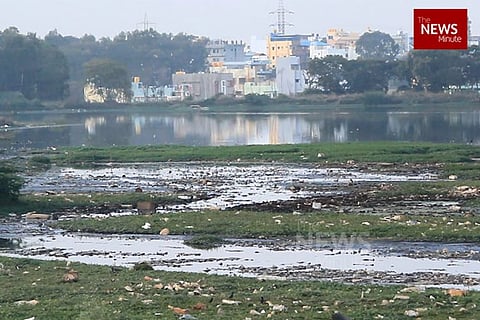

In the last 10 years, several people living in Bannigiri, Chowkahalli, K Gopahalli and other villages in the catchment area of the Byramangala reservoir have developed cancer or suffered from skin ailments, and many have died. “It’s because of the water and the soil," says Shankara, a resident of Bannigiri, "If we touch the soil or water with our bare hands, it burns. We get rashes and it is painful. Even if we wear gloves and boots while working, it does not help. The contamination is that bad."
Activists say that the lakes located in this belt have high levels of non-biodegradable chemicals, as well as heavy metals exceeding the industrial effluent discharge standards. “The problem is that not all factories have effluent treatment plants within their premises. According to the Karnataka State Pollution Control Board’s standards, the factories should set up Effluent Treatment Plants (ETP) to treat the effluents or send it to a common ETP, in case they don’t have the ability to run an ETP. This is not happening,” says Dr Sharadchandra Lele, a researcher with Ashoka Trust for Research in Ecology and Environment (ATREE), who has extensively studied the ecological damage caused by the industries in the area.
Sources in the KSPCB say that most of the industries have resorted to finding a backdoor to violate the norms. Several factories in the area do not have ETPs, officials say, and most of the industrial waste ends up flowing into the Byramangala Reservoir and the Vrishabhavathi River. According to a study by ATREE, the faecal coliform (FC) found in the water bodies in the industrial belt was 100 times greater than World Health Organisation (WHO) norms. Faecal coliform is a group of gram-negative bacteria that indicate the presence of pathogens in water.
Several residents have stated that the exposure to the toxic water has resulted in significant health issues for those living near the Byramangala reservoir. However, there have been no studies conducted to conclusively prove that there is a direct correlation between the pollution and the deteriorating health of the residents living in the areas surrounding the Byramangala reservoir.
Forty-five-year-old Vijayalakshmi is a resident of Chowkahalli village, which borders the Byramangala catchment. Nearly every shelf in her living holds a picture of her late son. “This one we took around the time we first took him to the hospital,” she says, handing over a picture frame. A huge swelling on the right side of his neck is easily visible in the picture. “He was only 7-years-old when he died,” says Vijayalakshmi. Her son was diagnosed with a type of leukaemia which doctors said was more common only in older age groups.
Watch Vijayalakshmi and others explain this public health issue: